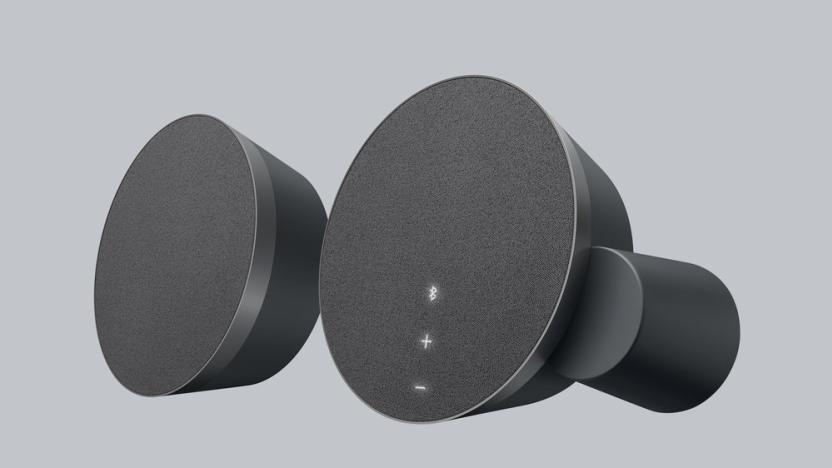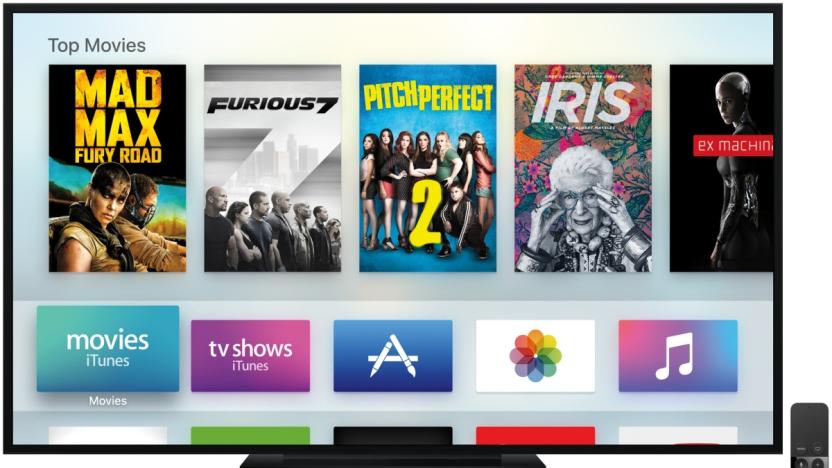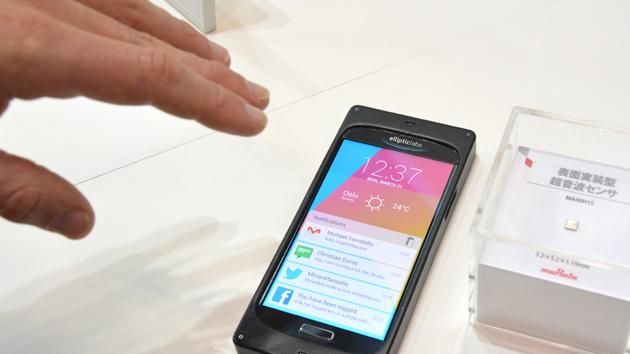motioncontrol
Latest

Logitech’s MX speakers have motion-activated controls
Among Logitech's suite of releases this week comes MX Sound, billed as 'the first premium Bluetooth speaker for your desk'. An elegant design and quality audio output make them a nice addition to your workspace, but it's the features within that actually make them a really useful addition. Alongside the ol' 35mm jack, you can pair up to two devices via Bluetooth and seamlessly switch between them. Simply pause music on one device and hit play on the other for instant playback -- no fiddling around with settings. You won't forfeit sound from your PC either, so you can play audio through a Bluetooth-connected device without missing alerts and chimes from your desktop.

'Street Fighter' on Nintendo Switch flings first-person hadokens
News keeps trickling in for the Switch as we await its public release next month. Befitting a Nintendo console, they range from exciting to bizarre, often taking the system's novel points and running into unpredictable territory. Such is the case with the upcoming Ultra Street Fighter II, as a new video emerged confirming rumors that we will, at last, get a first-person hadoken-throwing experience.

'Until Dawn' looked way different as a PlayStation 3 game
Until Dawn was my favorite game from last year. It had a rocky development history, though, starting as a first-person PlayStation 3 game that used the Move motion controller pretty extensively. And now, footage from an early prototype has surfaced online, showing off just what the game looked like as a motion-controlled PS3 title.

Researchers use the Force (in an Apple Watch) to fly a drone
Taiwanese tech researchers at PVD+ created an app for the Apple Watch that remotely controls a drone with arm movements, briefly turning pilots into Jedi. Reuters caught the motion-controlled drone in action and you can check it out in the video below. The team also created an app that controls light levels and colors via hand movements, and a spherical robot resembling BB-8, the adorable rolling droid from Star Wars: The Force Awakens. PVD+ is working on securing a patent for its software, which it calls "Dong," Reuters says.

The new Apple TV brings apps, Siri and a touchpad remote for $149
The new Apple TV is here, just unveiled at today's big event. Speculation about Apple's plans for the living room has circled for years, and this represents its most powerful assault on the space so far. A hardware refresh in 2012 added 1080p support, but not much else, so we're more than due for an upgrade, and exec Eddy Cue appropriately called today "a big day for the big screen." Tim Cook called it "the future of television," promising a new tvOS, App Store and showing off features including deep Siri integration with a new remote. That Siri Remote has a touchpad, mic and Wii-like motion controls built in, necessary for Siri to search across "multiple content options" (iTunes, Netflix, Hulu, HBO and Showtime, with more to come) on a single screen. Universal search is a feature already offered by competitors like Roku, Samsung, Amazon and Xbox that makes it easy to find a show or movie without having to know which service or app it's in first, and now it's on Apple TV too. There will be two versions of the new Apple TV: a 32GB model for $149, and 64GB model for $199, shipping in October to over 80 countries.

You can build Microsoft's Kinect-powered holodeck at home
Got a Kinect, a projector and a knack for code? If so, you can create a Star Trek-like holodeck in your living room. Microsoft has released the RoomAlive Toolkit, a software framework that lets you string together Kinect motion trackers to create interactive projection maps. You can use it to build anything from extra-immersive games through to art displays. This isn't exactly a trivial undertaking (Microsoft is promising lots of tutorials), but it means that you won't have to wait for someone else to bring your augmented reality dreams to life.

TV-ready game turns your Android phone into a tennis racquet
Android fans: you no longer have to watch on the sidelines as your friends play TV tennis with their iPhones. Rolocule has released Motion Tennis Cast, an Android version of its free sports game that uses screen mirroring tech (such as Chromecast, Miracast or Samsung's AllShare Cast) to turn your phone into a Wii Sports-like motion controller, with your TV or a Chrome browser tab serving as the screen. You'll largely be lobbing and volleying like you did in the iOS version, although there's a new multiplayer mode that lets you challenge your Facebook and Google+ friends. The real party trick may be coming down the pipeline, however. Rolocule is teasing plans for an Android Wear version, so you'll one day have the option of swinging with your smartwatch.

Nintendo and Philips settle their fight over motion patents
Philips made more than a few gamers nervous when it sued Nintendo over motion control patents back in the spring, but all that's water under the bridge as of today. The two companies have reached a truce that has Philips dropping its lawsuits in return for a patent cross-licensing deal. Neither firm is discussing the terms of the settlement, although Nintendo was clearly under the gun here -- it risked having to stop console sales during a US trial, which would have wrecked its already precarious finances. Regardless of who came out on top, it's safe to say that you won't have trouble picking up a Wii U in the near future.

At last, phones will get ultrasound gesture control in first half of 2015
We've been following Elliptic Labs' development on ultrasound gesture control for quite a while, but no time frame was ever given until now. Ahead of CEATEC in Tokyo, the company finally announced that its input technology -- developed in partnership with Murata -- will be arriving on phones in the first half of 2015. But that's not the only good news: On top of the usual swiping gestures for images, games and navigation (we saw some of this last year), there's now a new capability called "multi layer interaction," which uses your hand's proximity to toggle different actions or layers. It's potentially useful for glancing at different types of messages on the lock screen, as demoed in the video after the break.

The Trinity Magnum VR controller is like a PlayStation Move for your PC
The Oculus Rift isn't even a consumer product yet, but it already has a shadow hanging over its head: how, exactly, are its users going to interact with its intangible, virtual worlds? It's starting to look like the answer will be multifaceted, requiring users to own different devices for different gameplay scenarios. Trinity VR wants to be gamer's go-to product for the FPS genre, and have just launched a Kickstarter campaign to fund its Magnum VR controller. We caught up with the company in San Francisco to give its prototype controller a quick look; here's what we found out.

Rolocule's Motion Tennis will use Chromecast mirroring to recreate Wii Sports
Not sure how you'll use Chromecast's mirroring feature? Well, you could play tennis. About a year ago, Rolocule brought Wii-like gameplay to Apple users with Motion Tennis -- an app that leveraged Apple TV and iPhone AirPlay Mirroring to turn the user's handset into a virtual racket. Now the company is doing the same thing with Google's Chromecast. Using the mirroring feature announced at Google I/O, Rolocule has cooked up an early demo (available after the break) of Motion Tennis on a Nexus 5. The prototype has a noticeable input delay, but it's an excellent proof of concept for gameplay possibilities available to devices with screen mirroring. Don't have a Chromecast dongle? No worries, Rolocule says it's working on Miracast support too, and told Engadget that a public beta will be launching soon. Read on to see the Chromecast version of the game in action.

Microsoft's next big Windows Phone may use Kinect-like motion gestures
Yes, the Lumia 930 and 1520 are fine Windows Phones, but where's the sequel to the fan favorite, the 1020? Apparently, it's coming -- and it's bringing a clever control scheme along for the ride. Sources for both WPCentral and The Verge claim that Microsoft's future Lumia hardware, nicknamed McLaren, will incorporate both a giant camera and "3D Touch" that uses motion gestures (some of them Kinect-like) to control the phone without poking at the screen. We've seen some of the rumored concepts elsewhere; you can cover the phone to mute it, or bring it to your ear to answer. Others, however, are unique. McLaren will reportedly react to your grip, and will let you see features 'hidden' inside a Live Tile (such as messaging in the Facebook app) by making a tapping motion that doesn't touch the glass.

HP's Leap Motion keyboard to be sold separately for $99
The Leap Motion controller is currently present in three forms: a $74.99 standalone dongle, inside the special edition HP Envy 17 laptop and inside an HP keyboard. The dongle -- with almost half a million units sold since launch -- and the keyboard are obviously the only ways to add this hand motion sensor externally, but the latter option was limited to select HP computers to begin with. Well, not any more. At Computex, Leap Motion told Engadget that as of this month, you'll be able to purchase said keyboard for about $99, and it'll work on any Windows 7 or Windows 8 PC as long as you have the software installed -- be it the current version or the free V2 update with skeletal tracking coming this summer.

Leap Motion's latest motion tracking tech can see your joints
The Leap Motion controller is a curious little motion sensor, but it isn't always easy to use. The hand-sensing tech has a tendency to lose sight of where your fingers are and almost every application that uses it has its own learning curve. Soon, that might change -- today Leap is launching the public beta for its next generation (V2) tracking software. This free update makes some big promises, including improved resistance to sunlight and infrared interference, better tracking algorithms and, best of all, the ability to track individual joints. We dropped by the company's San Francisco office to try it out and found the update to be a significant improvement.

Disarm a bomb with your hand, a robot arm and Leap-motion controller
Neutralizing explosives, it turns out, is a delicate and complicated procedure -- but a company called Mirror Training hopes to make it simpler. "Our company has built an interface that literally uses your own hand and arm to move a robotic arm," announced CEO Liz Alessi. "I like to call it 'wear your robot.'" The interface uses a Leap Motion controller to detect an arm and hand movements, allowing a bomb squad robot to directly mirror its operator's actions. In tests, Alessi says, it has allowed operators to disarm mock-bombs twice as fast as traditional control methods.

Google's digital art prize winner is a poem you control with your body
Google asked artists to prove that code could be beautiful with its DevArt competition, and hundreds delivered on that promise. However, there can only be one winner: The Metamorphosis of Mr. Kalia, a visual poem from Cyril Diagne and Béatrice Lartigue. The project lets you use your body movement to control Mr. Kalia as he undergoes strange, symbolic transformations throughout his life. Metamorphosis is using little more than a standard Kinect sensor to track your motion and send it to a Chrome browser, so it's easy to both play with and set up -- it even works over a basic internet connection.

Motion-controlled Battroborg Warriors deliver armed robot combat
Last year's Battroborgs were a blast, but not without their quirks. Accuracy was not one of the tiny bot's strong points, and moving or turning was an exercise in frustration. This year, TOMY decided to simplify things a bit, while adding armed combat to the mix. The resulting Battroborg Warriors wield swords and scythes, and ditch the dual-fisted controls for a more streamlined system that uses only a single accelerometer-based remote. Obviously, we had to swing by the company's booth at Toy Fair to try our hand in a one-on-one battle against the reigning champion, Senior Brand Manager Tom Zahorsky.

Sony patent filing would let you reshape your PlayStation Move controller
Typically, motion controllers aren't very good at adapting to different gameplay situations -- not unless you're willing to slap on a cheap plastic shell, anyway. Sony may improve that state of affairs in the future, though, as it recently filed for a patent on a modular PlayStation Move controller. The concept lets gamers attach parts to the Move that change not just how it feels, but how it behaves in-game. A set of "limbs" would turn it into a humanoid, for example, while a rotating part could switch between a gun and a sword. It's an intriguing idea, although we wouldn't count on seeing it any time soon. A modular system would likely raise the price of a future Move controller, and Sony has lately focused more on the DualShock 4's Move-like features than dedicated peripherals.

iRing adds gesture-control capability to iOS music apps (video)
This year's CES has introduced us to a number of devices that cater to specific people. That includes IK Multimedia's iRing accessory, designed for aspiring DJs who'd like to control their iOS music apps with gestures... and a dash of showmanship. So long as a user's wearing the iRing, the iDevice's front camera picks the gesture controls up, and the peripheral's accompanying app translates them to commands music software can understand. According to the company (the same one responsible for a few other music accessories for iOS), the iRing's capable of controlling not only basic music apps, but also advanced ones designed for those who mix their own tunes. It also comes with a couple of its own music-editing apps that one can use to add effects and create non-stop loops. Those who prefer waving their hands in the air over poking at on-screen controls can get the iRing in various music and electronic retailers worldwide for $25. Update: We've just gone hands-on with the iRing at CES and gave it a whirl with iRing Music Maker, one of two apps (the other is FX Controller) that it can take advantage of at launch. The iRing setup consists of two plastic "rings," which have an array of three dots on each side. One end of the plastic peripheral has the specks ordered into a triangle, while the other side has them in a line. An iOS device's camera recognizes the dot formation and controls the mapped function. Push one hand in and out to cycle through music effects or use your other paw to vary intensity. It works as promised, but we wouldn't consider it terribly useful -- unless, of course, you're a DJ only interested showmanship.

PrioVR full-body mocap suit promises accurate motion tracking in VR gaming
Sure, Kinect's done a bang-up job of bringing full-body motion tracking closer to the mainstream, but it hasn't exactly fulfilled the dreams of futuristic gaming that Hollywood (and our imaginations) promised. PrioVR, a motion-tracking suit meant for virtual reality games, aims to bring us closer to that future with accurate full-body motion-capture abilities without a camera array in the mix. The demo on hand today was pretty impressive: A rep was decked out in the upper-body suit, complete with Wii nunchuks, playing a first-person shooter. Sensors on his chest, back, head, arms and hands translated his movements to the screen with little latency, showing up on the display in a fraction of a second. We did notice an ever-so-slight choppiness -- which could have more to do with the game engine than the hardware -- but how much it affects gameplay remains to be seen. Though only an upper-body rig was being shown off, a full-body getup promises to capture everything from walking to kicking.










